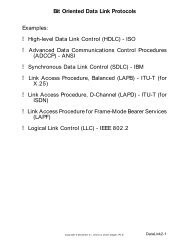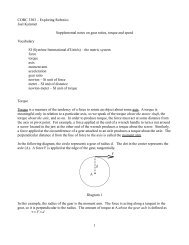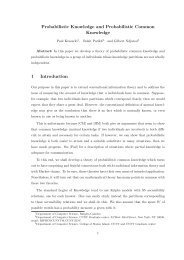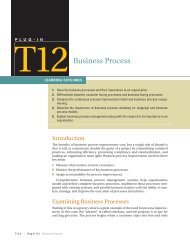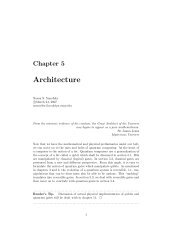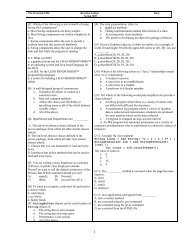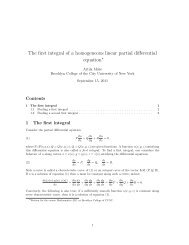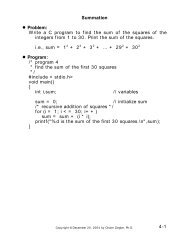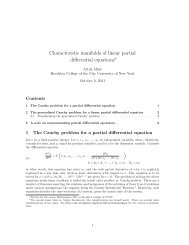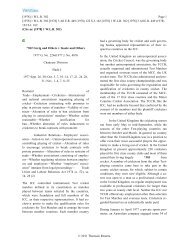Number Systems Humans use the decimal number system to ...
Number Systems Humans use the decimal number system to ...
Number Systems Humans use the decimal number system to ...
You also want an ePaper? Increase the reach of your titles
YUMPU automatically turns print PDFs into web optimized ePapers that Google loves.
first position <strong>to</strong> <strong>the</strong> right of <strong>the</strong> <strong>decimal</strong> place tells how many 10-1's are in <strong>the</strong> <strong>number</strong>, and <strong>the</strong><br />
second position <strong>to</strong> <strong>the</strong> right of <strong>the</strong> <strong>decimal</strong> place tells how many 10-2's are in <strong>the</strong> <strong>number</strong>, etc.<br />
Thus .25 means 2 * 10-1 or 2 times 1/10 or 2/10 (or 20/100), while .05 means 5 * 10-2 or 5 *<br />
1/100 or 5/100), and <strong>the</strong> sum of those is 20/100 + 5/100 or 25/100ths. (For simplicity, we will<br />
ignore <strong>decimal</strong> places in our discussion below.)<br />
Counting<br />
Counting in all <strong>number</strong> <strong>system</strong>s works <strong>the</strong> same way: start at 0 and increment by 1 till<br />
you reach <strong>the</strong> maximum digit in <strong>the</strong> <strong>number</strong> <strong>system</strong>. Then put down a 0 and carry a 1 <strong>to</strong> <strong>the</strong> next<br />
column, adding it (if necessary) <strong>to</strong> <strong>the</strong> value already <strong>the</strong>re. As an example, in <strong>decimal</strong> we count<br />
from 0 <strong>to</strong> 9, which is <strong>the</strong> maximum digit; <strong>the</strong>n we put down a 0 and carry <strong>the</strong> 1, yielding 10. We<br />
do <strong>the</strong> same process in <strong>the</strong> rightmost column until we reach 19; <strong>the</strong>n we put down a 0, carry <strong>the</strong> 1<br />
and add it <strong>to</strong> <strong>the</strong> 1 already <strong>the</strong>re <strong>to</strong> produce 20. When we reach <strong>the</strong> maximum <strong>number</strong> in every<br />
column, we put down 0's and carry <strong>the</strong> 1 <strong>to</strong> <strong>the</strong> next column: for example, we move from 99 <strong>to</strong><br />
100, or from 999 <strong>to</strong> 1000.<br />
Binary <strong>Number</strong> System<br />
The binary <strong>number</strong> <strong>system</strong> (base 2) has two digits, <strong>number</strong>ed from 0 <strong>to</strong> 1. The computer<br />
<strong>use</strong>s <strong>the</strong> binary <strong>number</strong> <strong>system</strong> <strong>to</strong> represent <strong>number</strong>s internally (it <strong>use</strong>s <strong>the</strong> <strong>decimal</strong> <strong>system</strong> for<br />
input/output of numeric values). The smallest unit of s<strong>to</strong>rage in <strong>the</strong> computer is <strong>the</strong> bit, which<br />
stands for binary digit. A bit can hold one of two values, 0 or 1; <strong>the</strong>se are <strong>the</strong> only symbols that<br />
are <strong>use</strong>d <strong>to</strong> represent <strong>number</strong>s in <strong>the</strong> binary <strong>system</strong>. All o<strong>the</strong>r values are represented by<br />
combinations of bits. The 0 and 1 values are often interpreted as false and true, or as an electrical<br />
impulse being off and on. A sample binary <strong>number</strong> looks like this: 101110. Note: this is also a<br />
<strong>number</strong> in <strong>the</strong> <strong>decimal</strong> <strong>system</strong> – one hundred and one thousand, one hundred and ten. We will<br />
always try <strong>to</strong> make clear which <strong>system</strong> is being discussed.<br />
Counting in Binary<br />
Counting in binary is <strong>the</strong> same as in <strong>decimal</strong>, but we hit <strong>the</strong> maximum digit in a column<br />
more often (in fact, it happens every o<strong>the</strong>r <strong>number</strong>--do you see why?):<br />
Decimal Binary<br />
0 0<br />
1 1<br />
2 10<br />
3 11<br />
4 100<br />
5 101<br />
6 110<br />
7 111<br />
8 1000<br />
9 1001<br />
10 1010<br />
11 1011<br />
12 1100<br />
13 1101<br />
14 1110<br />
15 1111<br />
16 10000




